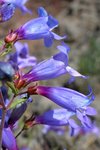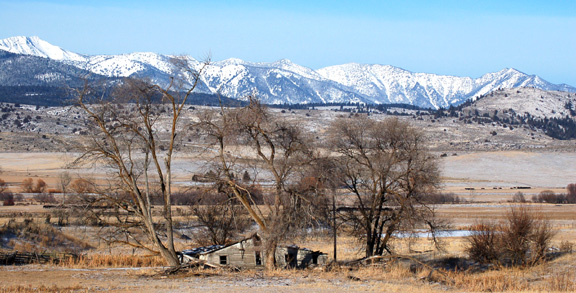- Wallowa Wildflowers Part 2
- What’s with Baker City Gas Prices?
- Federal judge rules gray wolves in Oregon were illegally removed from the protections of ESA
[Edited 8/22/10; segment deleted for personal reasons]
________________
Wallowa Wildflowers Part 2
 Helianthella uniflora
Helianthella unifloraThis is the second installment of an article displaying some of the common wildflowers that can be found near the 66 Forest Service Road between Halfway and Twin Lakes (and beyond) in the Wallowa Mountains, Baker County, Oregon.
This 2nd portion of the article begins where the 1st part (July 28th) left off, to the east of Trinity Creek, at about 6300 feet in elevation. There is a short spur road there leading to a rocky outcrop and a sometimes used campsite, where a few of the previously listed wildflowers occur, as well as the first following.
One-flower Helianthella (Helianthella uniflora), is a rather tall perennial with several to many long rangy stems from the base, each one with normally only one large yellow flower at the end. Our usual variety is Douglas' helianthella (Helianthella uniflora var. douglasii). Frankly, I can scarcely tell the difference between the two varieties most of the time, but this one appears to be douglassii. It can be found along the upper 66 Road and on the Hells Canyon Rim, among other areas, often on rocky slopes.
Helianthella was used by the “First Nations.” AKA Native Americans, for an analgesic, usually as a poultice of ground roots, to treat sprains, swelling, and rheumatism.
 Helianthella uniflora
Helianthella unifloraIn this same area can be found Blue Stickseed (Hackelia micrantha), also known as Jessica sticktight and wild forget-me-not, a widespread and common species in the Blue Mountains of Oregon. It appears in the lower elevations but is prominent in meadows and openings of the middle and higher elevations.
 Blue Stickseed (Hackelia micrantha)
Blue Stickseed (Hackelia micrantha)According to Wallowa-Whitman National Forest herbarium records, blue stickseed increases in overgrazed areas. “Increasers” in a grazed situation are those plants that increase due to their degree of distaste by livestock, either because they have poisonous properties or due to other factors, such as coarseness and aggravating seeds, or the effects of grazing on the ecosystem itself through disturbance, etc.. Three obvious increasers to look for in the Wallowas and elsewhere, out of the many to choose from, are Hackelia, lupine, and false hellebore (to be described later, aka, skunk cabbage). When pondering a portion of the forest that has been grazed for many decades, you can bet that the plant community you are looking at is quite a bit different from what it was before cattle and sheep were allowed to have at it. Some species of plants and the insects and other species that depend upon them, may be greatly diminished (eg. bunch grasses), or may have disappeared all-together.
 Blue Stickseed
Blue StickseedStickseed grows in abundance in more open disturbed areas, whether caused by grazing, fire, campers, timber extraction, or firewood seekers. The seeds, nutlets, have prickly stiff hairs that have small barbs around the tip, as in the photograph above. This characteristic allows the seeds to cling to passing wild animals, livestock, hikers, and their dogs, thus helping to disperse the seeds over a much wider area. You may remember pulling them off your clothing or combing them out of your pet’s fur—great fun! Despite their aggressive seed dispersal “strategy,” most generally appreciate them due to the delicate and attractive flowers.
Although some species of Hackelia were used by some First Nations, for uses such as serious wound injuries and cancer (????) treatment, accounts of use by North West tribes are hard to come by.
 Blue Stickseed
Blue StickseedAnother interesting and attractive, mostly sub-alpine, plant in the area is found close to creeks, from at least as low as Trinity Creek, on up in elevation to Lake Fork Creek, Big Elk Creek, and beyond, and is called Cusick's fumewort (Corydalis caseana Gray ssp. Cusickii), AKA “Fitweed.“ It is consumed by cattle and sheep but is non-the-less somewhat toxic. It apparently gives them fits and may cause losses.
 Cusick's fumewort (Corydalis caseana Gray ssp. Cusickii)
Cusick's fumewort (Corydalis caseana Gray ssp. Cusickii)It is from a fairly unusual family of plants called the Fumeworts or Fumitory family; the Fumaracea. There are only four genera listed for this family in Hitchcock and Cronquist’s “Flora of the Pacific Northwest,” which includes the familiar Bleeding Heart (Dicentra formosa). Cusick's fumewort is named for perhaps the most famous early botanist/plant collector/explorer/rancher in our area, William Cusick. (The map included in the link shows many plant collection points in Union, Baker, and Wallowa Counties, as well as the rest of Oregon.) Several plants and a local mountain are named in his honor. I first encountered plants named after him in northeastern most California some years ago.
 Cusick's fumewort
Cusick's fumewortAcetylcholinesterase (AchE) inhibitors, such as those found in the genus Corydalis, and other members of the family, are thought by some to be useful in treating “Alzheimer's disease (AD), senile dementia, ataxia, myasthenia gravis and Parkinson's disease.” [In Acetylcholinesterase inhibitors from plants]
 Heartleaf Arnica (Arnica cordifolia)
Heartleaf Arnica (Arnica cordifolia)Another common and widespread wildflower from lower elevations and on into the sub-alpine elevations of the Wallowas, including the Hells Canyon Rim, is Heartleaf Arnica (Arnica cordifolia). This is a very common montane perennial in North America, including much of Canada, a few northern mid-western states, and appears in the west from the Dakotas south to New Mexico and westward to the Pacific coastal states. It is seen roadside in partially shaded areas along the 66 road and was fading when I was there in July, so I have used photos from other locations during previous trips in the Blue Mountains.
 Heartleaf Arnica
Heartleaf ArnicaIt is fairly easy to identify due to its large, heart-shaped (chordate), and usually toothed, lower leaves, and the single large yellow “sunflower” atop the flowering stem.
This plant has been reported to have been used for many ailments by the Native Americans, including bruises, cuts and swellings, sore eyes, and as a “love medicine” (hmmm!).
 Heartleaf Arnica
Heartleaf ArnicaWhen you get to the streamside and bog communities of the sub-alpine zone, a whole new world of plants presents itself. There are a number of interesting and attractive plants in these communities, some threatened by grazing (more to follow in future blogs). Here is one member of this community from Lake Fork Creek below the 66 Road.
 Bull elephant's-head, elephanthead lousewort, or simply Elephant Heads (Pedicularis groenlandica)
Bull elephant's-head, elephanthead lousewort, or simply Elephant Heads (Pedicularis groenlandica)Elephanthead lousewort is a lousewort of the figwort family of plants (Scrophulariaceae), which also includes such notables as the Penstemons and Paint-brushes. This non-toxic, spring and summer perennial is quite common in wet or boggy meadow environments from all of the western states, including Alaska, and almost all of Canada.
 Bull elephant's-head or Elephanthead lousewort
Bull elephant's-head or Elephanthead lousewortElephant heads was ingested by some Native American tribes to treat coughs. Some modern folklore lists the genus as having value for use as “tranquilizers, muscle relaxants, powerful aphrodesiacs, and sedatives.” I am just glad it is out there.
 Bull elephant's-head or Elephanthead lousewort
Bull elephant's-head or Elephanthead lousewortThat’s all the time I have for Wallowa Wildflowers-- Part 3 later.
_____
What’s with Baker City Gas Prices?
 Pricing at Jackson Shell
Pricing at Jackson ShellI can hear readers thinking, please tell me something I didn’t already know, but I thought it was worth documenting our relatively expensive gasoline prices. I think paying more for fuel may not necessarily be a bad thing, but the excess profits should probably go for alternative transportation, renewables, and etc., rather than to, well, you know. Those who have traveled beyond Baker City to places as close as La Grande, Halfway, or Ontario, may have noticed that our prices for unleaded regular are almost always higher here than in these nearby communities (I’m not including restricted “card-lock” stations as it seems to me that due to lower labor costs, they should and often do have lower prices.).
The Baker City gas price issue came to my attention again this year when I made trips to or through the nearby communities mentioned over the last three months, and noticed their low price was sometimes as much as 20 cents or more per gallon lower, excluding Halfway. It would be nice if I had solid answers to the question as to why this is so, but I don’t. The hauling distance to these communities, except perhaps Halfway, are not so much higher that the distance alone could account for the differences. In fact, if hauling distance were a large factor, one must wonder why the price in Halfway was a penny lower than Baker City’s lowest price during July and into August. I’m guessing some of you have reached a conclusion of your own, with the initials PG. (Hint—the G stands for gouging.) Another related explanation may be a sort of non-conspiratorial sort of price fixing, where the owners gauge their pricing by comparison to other prices at stations in their captive driver sphere of influence (such as can be seen in many small towns). I hope there is a more agreeable explanation, and if you have one, please send it to me at refugee2000@gmail.com, or simply use the comment facility at the bottom of the blog.
Before I get to far along, here is a graph of the recent historical price in Oregon via GasBuddy.Com, which can be found at oregongasprices.com.
 Oregon Gas Price Chart Showing Average Retail Price in Oregon from May 5th to August 5, 2010.
Oregon Gas Price Chart Showing Average Retail Price in Oregon from May 5th to August 5, 2010. Price for unleaded regular at Oregon Trails RV Park (Oregon Trails West)
Price for unleaded regular at Oregon Trails RV Park (Oregon Trails West)During that period, the low price for unleaded regular in Baker City, up at the Oregon Trail RV Park, ranged from around $3.18.9 on May 12th, when the average Oregon price was about $2.95.9, to $303.9 over much of June, July, and into August, when the average Oregon price ranged from $2.83.9 to roughly $3.00. By contrast, the price at the Pilot station at the main freeway interchange in Ontario, hung persistently at $2.95.9, and the price at Safeway in La Grande varied from $2.96.9 to (just recently), $2.99.9 (three cents lower if you have a Safeway card). Baker City gas stations are consistently 3 to around 6 cents per gallon higher than Oregon Trail RV Park. If you were to chart our prices over the same period using the graph above, our prices would be off the chart in a nearly straight line. So far, while the state-wide average has climbed rapidly over the last two weeks, our prices have held steady, but tomorrow is a new day.
 Pricing at Gas & Snack on 10th Street
Pricing at Gas & Snack on 10th StreetCurrent Regular Unleaded Gas Prices for Oregon (Average), Baker City, and nearby communities (all from August 4th, except for Gas & Snack, Halfway, Safeway La Grande, and Ontario Pilot, which are from today.). Some prices from August 4th may have increased today.
Current Oregon average unleaded gas price $3.00.9
Shell Station at Highway 7 and David Eccles Road (no gas yesterday). $3.09.9
Jackson Shell just west of the freeway on Broadway $3.09.9
Chevron, just east of the freeway on Broadway $3.09.9
Chevron at Auburn & Main $3.08.9
Truck Corral, just east of the freeway on Broadway $3.07.9
Sinclair Station at Broadway & Cedar $3.07.9
Albertsons Express on Broadway $3.06.9
Gas & Snack on 10th and Church $3.06.9
Oegon Trail RV Park on Cedar/Hwy 86 near the north interchange $3.03.9
Richland Feed & Seed in Halfway $3.02.9
Safeway in La Grande (3 cents less with Safeway card) $2.99.9
Pilot at the freeway in Ontario $2.95.9
_____
Federal judge rules gray wolves in Oregon were illegally removed from the protections of ESA (From HCPC)
On the heels of the Payette's decision to protect Bighorn Sheep on the Idaho side of Hells Canyon, we are celebrating another big success for wildlife here at HCPC! Today, a federal judge ruled that gray wolves in Oregon were illegally removed from the protections of the Endangered Species Act. The Gray Wolves are now back on the Endangered Species List and will be guaranteed the guardianship they need to thrive in Oregon.
HCPC and other groups have worked diligently to assure the Gray Wolf remains protected under the Endangered Species Act, and with your support it has paid off!
Here are some of the decisions :
The Endangered Species Act does not allow the U.S. Fish & Wildlife Service to list only part of a "species" as endangered, or to protect a listed distinct population segment only in part as the Final Rule here does; and
The legislative history of the Endangered Species Act does not support the Service's new interpretation of the phrase "significant portion of its range." To the contrary it supports the historical view that the Service has always held, the Endangered Species Act does not allow a distinct population segment to be subdivided.
Click here to see the entire decision.
We’re excited about the decision. It allows us to step away from the current controversy and gives us a fresh opportunity to bring all parties together to work on a true science-based recovery plan for wolves. This also gives us time to work on updating the Oregon Wolf Plan without the added pressure of having to simultaneously implement it.












1 comment:
Suggestion
Mr. Brocato request a different judge. Baxter favors women.
Post a Comment